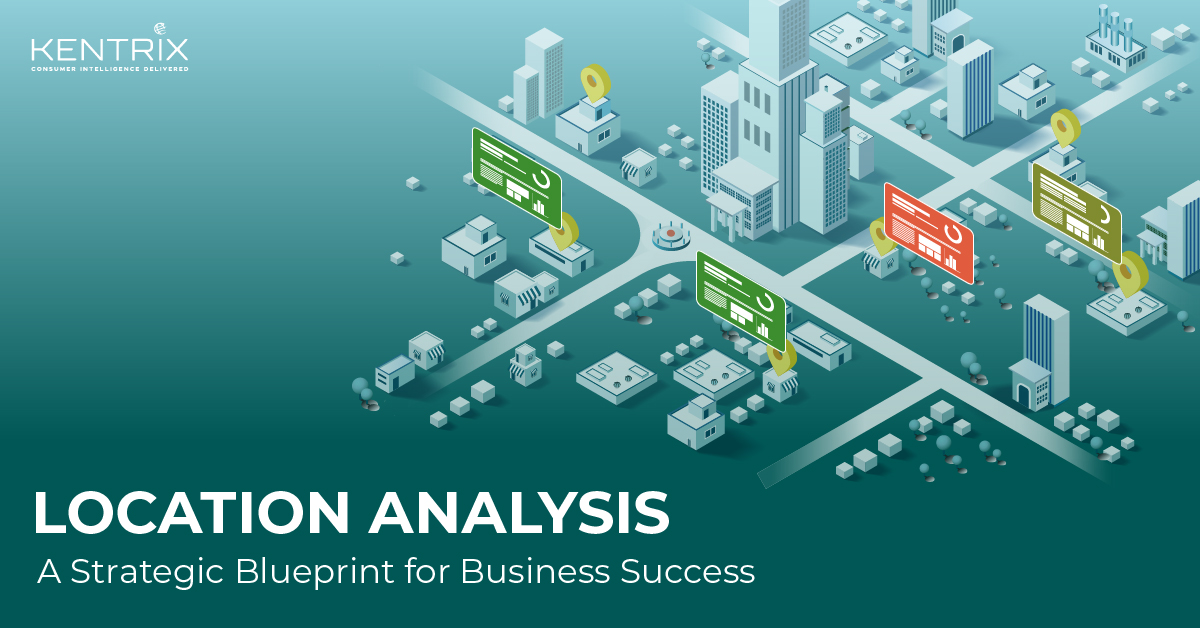
The adage – “Location is everything” is true not just when buying property but equally important when selecting your business site. Today, where you do business is just as important as your product. Location decisions shape brand positioning, sales and revenue and brand reputation. A great product in the wrong location can fail, while an ordinary product at the right location can create waves.
This is where location analysis comes in. Each micromarket is evaluated using data-driven insights to determine the most strategic places to expand, operate or market. Today, location analysis has evolved far beyond traditional site selection. It’s now powered by advance location intelligence, which layers geospatial data with demographics, consumer behavior,
From retail store openings and bank branch placements to quick commerce dark store planning, businesses across industries are using location analysis to gain a competitive edge. This article explores why it’s so important, what it involves, and how to leverage it for sustainable growth.
What Is Location Analysis?
Location analysis is the systematic potential of evaluating potential of existing business sites based on multiple factors – from population demographics and customer profiles to infrastructure, competition and accessibility. It helps answer questions like:
- Where should we open our next branch or outlet?
- Which location offers the best mix of demand potential and operational feasibility?
- How can we adjust our existing footprint to improve performance?
Historically, location analysis relied on basic metrics like population density, income averages, or visible footfall. While these factors are still relevant, modern businesses recognize they are not enough. A busy area doesn’t automatically mean high conversions; an affluent PIN code doesn’t guarantee spending in your category.
Today, location analysis has become much more evolved. It is powered by an AI driven location intelligence platform like Kentrix’s Geomarketer that integrates lifestyle segments, spending patterns, all this mapped to household level. Having access to such a location intelligence tool can sometimes be the difference between success and failure.
Importance of Location Analysis
Location analysis can play a pivotal role in ensuring that every physical and operational investment delivers maximum returns:
-
Match Right Market with Right Offer
Every market is unique. Even within the same micromarket, two neighbourhoods 100m apart can have completely different consumer behaviors, price sensitivities and product differences. Location analysis ensures that your offering, whether a retail store, a restaurant, or a service centre is aligned with the needs, expectations and spending power of the local audience.
-
Optimize Operational Efficiency
Strategically chosen locations help in streamlining logistics, reducing delivery time and properly allocating resources. For example, a quick commerce company can place dark stores in areas with the highest density of high-value customers, ensuring faster fulfillment and better coverage.
-
Gain Competitive Advantage
By understanding underserved areas and market gaps, brands can spot opportunities before their rivals. This first-mover advantage can be a distinguishing benefit in FMCG, QSR and quick commerce space.
5 Key Factors Considered in Location Analytics
Below are a few important factors to consider in location analytics:
-
Demographics & Household Level Consumer Profile
At the core of location analysis is understanding who lives, works, or visits the area. This includes population size, density, age distribution, gender split, household size, income levels, and education levels.
But demographics alone don’t tell the full story. Businesses need to look deeper into lifestyle segments, spending habits, and cultural preferences. For example, two neighborhoods may have the same average income, but one might prioritize spending on experiences while the other prefers durable goods.
Modern tools like Kentrix’s Geomarketeer provide household-level profiling, revealing not just the broad demographics but also the buying motivations and category affinities of each micro-market.
-
Footfall & Mobility Pattern
Understanding how people move in and around an area is critical. Mobility patterns reveal:
- Daily and weekly traffic peaks.
- The mix of resident vs. transient populations.
- Commuter flows during working hours vs. weekends.
For example, a store near an office hub may thrive on weekday lunch traffic but see low evening sales. Conversely, a residential area might have slow weekday mornings but high evening activity.
Location analysis uses real-time mobility data from GPS, Wi-Fi, and IoT sensors to map these patterns.
-
Competition Mapping
A good location is not just about customer potential but also about the competitive landscape. Competitor analysis is about identifying who are the competitors operating nearby, what’s their market positioning and if there’s any market cannibalization. Sometimes being closed to competitors creates a destination hub while in other cases it can also lead to cannibalization. Location analysis identifies both opportunities for differentiation and areas where there is cut throat competition.
-
Catchment Area
The catchment area refers to the geographical zone from which a business draws its customers. Defining it accurately is critical for realistic performance projections.
Instead of relying on arbitrary radius circles, modern location analysis uses drive-time catchments and real mobility flows to reflect how far customers will actually travel for a given product or service. Within each catchment, analysts study the customer density, lifestyle segmentation, spending potential across categories and overlap with competing outlets.
-
Future Growth Potential
While the location’s current profile matters, it’s future trajectory matters even more. In location intelligence, even the upcoming infrastructure projects (metro lines, flyovers), planned residential or commercial developments are considered. Investing in areas on the verge of growth can deliver long-term gains, even if short-term metrics seem modest.
Benefits of Location Analysis for Business
Below are the detailed benefits of location analysis for business:
-
Identify & Target High-Potential Micro Markets
By understanding holistic consumer profiles, you can expand into areas where your target audience resides. This helps avoid wasting resources on low-potential zones that might look attractive on paper but lack the right customer mix or demand drivers.
For example, a retail chain selling affordable biscuits and snacks can prioritize localities where spending patterns and lifestyle segments align closely with its product range, instead of simply chasing areas with high average incomes.
-
Reveal Hidden Trends & Opportunities
Location analysis uncovers patterns that traditional market research often misses. This could be a micro-market where demand for a product category is growing faster than the city average, or an overlooked cluster of high-value customers within an otherwise average-looking area.
These insights allow businesses to move first — securing strategic sites or launching targeted campaigns before competitors spot the opportunity.
-
Reduces Risk & Prevents Cannibalization
Opening a new store, branch, or warehouse is a significant investment. Without thorough analysis, businesses risk choosing locations with low actual demand, logistical challenges, or heavy competition.
By simulating performance scenarios and studying real-world factors like catchment overlap, accessibility, and competitor strategies, location analysis helps avoid expensive missteps and ensures that every new site contributes to growth rather than cannibalizing existing operations.
-
Optimize Operational Efficiency
The right location helps in streamlining operations. It can reduce delivery times, minimize logistics costs, and improve supply chain reliability.
For example, in quick commerce or e-commerce, placing hubs in zones with high order density ensures faster fulfillment and reduced last-mile costs.
-
Improve Marketing ROI
Location analysis identifies where marketing will have the greatest impact, enabling hyperlocal campaigns that target only those areas with high conversion potential.
Instead of running citywide promotions, brands can focus budgets on specific neighborhoods where customer affinity is highest. This reduces wasted ad spend and increases campaign effectiveness, particularly for categories where purchase intent is location-sensitive (e.g., QSR offers, retail sale events).
-
Get Competitive Advantage
Businesses that invest in location analysis gain a first-mover advantage in capturing high-value sites and markets. They can spot white spaces, underserved catchments with high demand potential and secure them before rivals.
This strategic foresight can lead to higher market share, better brand visibility, and stronger local dominance.
-
Maximize the Current Value
Location intelligence is not just for expansion but also for optimizing existing networks. By evaluating store-level performance against local market potential, businesses can reallocate marketing spend, adjust product inventory, reconfigure store formats and also decide when to exit underperforming sites. This ensures that every location operates at its full potential.
Tool Used in Location Intelligence
Geomarketeer is Kentrix’s AI-powered location intelligence tool designed to give businesses unprecedented clarity into micromarket opportunities across India. Built on the Geographic Information Systems (GIS) framework, this location intelligence software delivers deep consumer insights at a household level, covering 92 crore Indians across urban and rural geographies.
With Geomarketeer, businesses can instantly generate catchment reports for any location in the country. These reports go beyond basic demographics, offering lifestyle segmentation, income distribution, spending patterns, brand affinities, and product category propensities within precise drive-time or walk-time zones. This hyperlocal intelligence enables smarter site selection, demand forecasting, distributor network planning, and hyper-targeted marketing campaigns.
As a SaaS platform, Geomarketeer gives you on-demand access.
Top Industries Leveraging Location Analysis
-
Banking & Financial Services
Banks use location intelligence to identify high-potential areas for new branches, optimize ATM networks, and align financial products with local customer needs.
-
Retail
Location analytics in retail involves choosing the best store locations, understand local shopper profiles, and personalize promotions based on catchment-level consumer behavior.
-
Quick Commerce
Quick commerce companies use location data to place dark stores strategically, plan efficient delivery routes, and forecast hyperlocal demand in real time.
-
FMCG
FMCG companies leverage it to map distributor coverage, identify demand hotspots, and plan van routes and product mix based on catchment-level insights.
-
Food & Beverage
F&B brands use it to predict sales demand, avoid store cannibalization, and plan outlet launches based on local consumption patterns.
-
D2C
New age startups leverage locality level consumer data to assess total addressable market for their products before setting up their supply chain network.
The Future of Location Analysis
The future of location analysis will be shaped by real-time data, AI-driven predictions, and hyperlocal consumer intelligence. As a leading location intelligence company in India, Kentrix is at the forefront of these changes. In collaboration with Stanford University, we have developed an AI based sales prediction engine that can forecast sales. There will be more of such predictive models that can optimize supply chain and simulate market changes before they happen. The next generation of location analysis will combine GIS mapping, household-level data, and behavioral insights.


